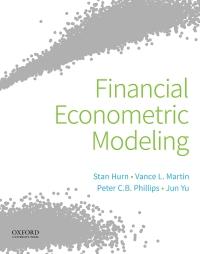Linearising the Euler equation in the consumption CAPM model results in a a linear regression model between
Question:
Linearising the Euler equation in the consumption CAPM model results in a a linear regression model between the log returns of a risky asset and the growth rate in consumption
\[
r_{t+1}=\beta_{0}+\beta_{1} \Delta c_{t+1}+v_{t+1}
\]
in which
\[
\begin{aligned}
\beta_{0} & =-\log \delta-\frac{1}{2}\left(\gamma^{2} \sigma_{c}^{2}+\sigma_{r}^{2}-2 \gamma \sigma_{c r}\right) \\
\beta_{1} & =\gamma \\
v_{t+1} & =u_{1 t+1}-\gamma u_{2 t+1}
\end{aligned}
\]
In this expression, the slope parameter of the regression equation is in fact the relative risk aversion coefficient, \(\gamma\).
(a) Estimate \(\gamma\) by ordinary least squares. What is the problem with using this estimator to compute the parameter estimates of this model?
(b) Estimate \(\gamma\) by instrumental variables using
i. \(\Delta c_{t}\) as an instrument \(\Delta c_{t+1}\); and
ii. \(\Delta c_{t}\) and \(r_{t}\) as instruments \(\Delta c_{t+1}\).
Comment on the results.
(c) Perform a series of tests for weak instruments for the regressions in part (b). What do you conclude.
(d) Is it appropriate to implement the Anderson-Rubin test for robust inference on \(\beta_{1}\) and hence \(\gamma\) in the structural equation.
Step by Step Answer:

Financial Econometric Modeling
ISBN: 9781633844605
1st Edition
Authors: Stan Hurn, Vance L. Martin, Jun Yu, Peter C.B. Phillips





